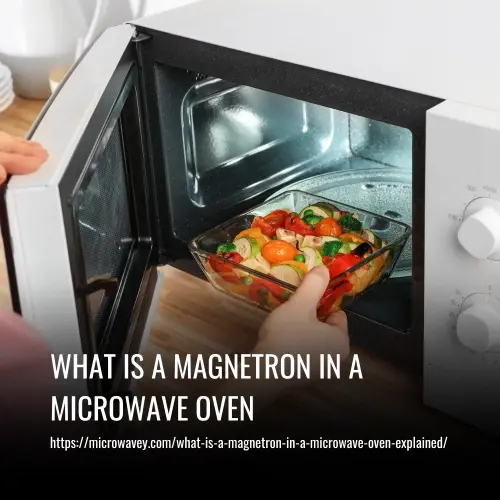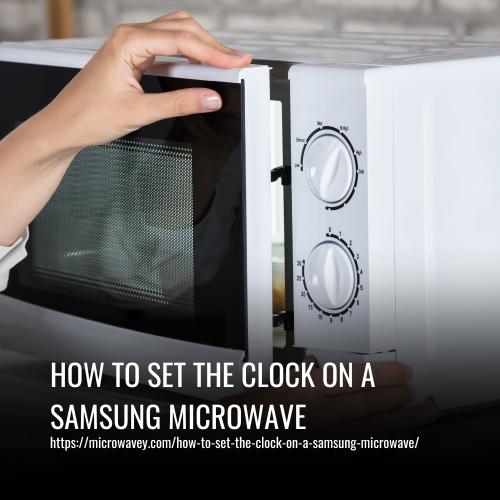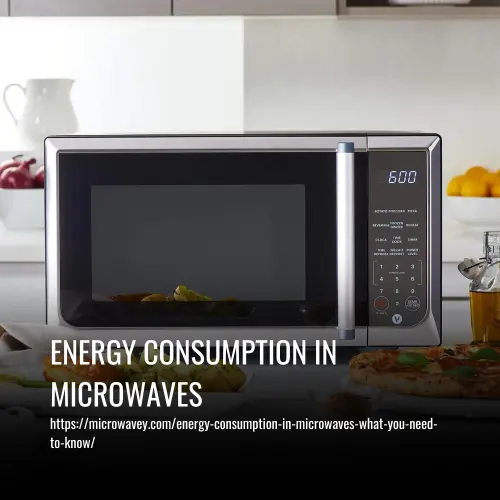A magnetron is a device inside a microwave oven that produces microwave radiation to heat food. It does so by using a heated filament and a magnet to produce a swirling field of electrons, which resonate with channels in the anode to create a stream of microwaves.
Let’s take a look at how magnetrons produce microwaves, how those microwaves heat your food, and how the device has evolved over the years.

How Does a Magnetron Work?
The magnetron is the heart of the microwave oven, the power generator that converts electricity into microwave radiation that heats the food inside the oven’s cavity. The way it does that is pretty sweet.
Electrons
The first step in the process happens inside a vacuum tube and involves a filament being heated up by electricity. The filament is made of tungsten or a tungsten alloy, and when it’s heated, it emits electrons.
In any other case, those electrons would simply shoot away in a direction generally aligned with the rod to which the filament is pointed, but that’s not what happens here.
A round magnet, placed behind the filament, creates a magnetic field that influences the electrons, and instead of zipping away, they swirl around the filament like a school of negatively charged fish.
Resonance
As the electrons swirl around, they cross over the walls of the resonance chambers in the anode. The anode is a metal part of the vacuum tube divided into many sections. One contains the filament, and the rest are the resonance chambers, which are essential for creating microwaves.
I call them resonance chambers because they’re essentially “tuned” to produce microwaves at 2.45 GHz. When electrons go by one of the chambers, they hit another electron at just the right time to produce an electric field within the chamber. Electric fields like that are produced in each chamber.
Microwave Emission
Once the energy is produced, it has to be directed into the oven cavity. That’s the job of a rod that conducts the energy from one of the resonance chambers and through the cap of the magnetron, which is on the opposite side of the filament.
The microwaves run along the direction of the rod, through the cap, and out of the magnetron.
But it wouldn’t do to stream microwaves into the cavity light the beam of a flashlight: that would be much too focused, and you’d end up with food that was cooked unevenly.
So, the microwaves are directed into a component called a waveguide, which channels the microwaves into the oven cavity in a way that they can easily scatter, spreading out and scattering all over the cavity. The walls of the oven cavity reflect the microwaves, making them continue to bounce around the cavity until they hit something that will absorb them, like food.
Voltage Variables
Now, if you’ve used multiple different microwaves, or you’ve read the microwave instructions on the back of popcorn bags of other microwaveable packaged foods, you’ll know that different microwaves have different voltages, and that affects the power of the microwave and how well it heats the food.
That’s because different voltages affect how the magnetron works.
The voltage determines how quickly the electrons swirl around the filament in the first step. A higher voltage will make the electrons go faster, and a lower voltage will make them go slower.
That means that a higher voltage will produce microwaves more rapidly, because the electrons cross the channels of the resonance chamber more frequently, which gives them more chances to produce microwaves than a lower voltage magnetron would have in the same amount of time.
Therefore, some microwaves work much better than others, and when you encounter a new one, you end up having to relearn all the best times and power levels to use to heat your favorite foods.
How do Microwaves Cook Food?

Microwaves constitute a high-frequency section of the radio wave section of the electromagnetic spectrum. That means they have a lower frequency than visible light and infrared light, but a higher frequency than other radio waves.
So they have enough energy to heat things up, but not enough to cause you any immediate damage. To be on the safe side, though, microwave ovens are built to keep the waves in, both with special insulation and a redundant lock that stops the magnetron from working when the door is open.
Even the holes in the door are too small for the rays to get through. And if you open the door partway through your timer, the magnetron is deactivated, and you don’t have to worry about any residual microwaves escaping because, like every other form of electromagnetic radiation, they move at the speed of light. So you’re completely safe as long as the oven is intact.
Inside of a microwave oven, microwaves bounce around the cavity, eventually ending up absorbed by the food inside. The microwaves penetrate the food and excite the particles inside of it. Water and fat-based particles are the most easily excited. Fiber and other dry matter doesn’t excite as easily because their particles have stronger mechanical and chemical bonds.
That’s why it’s a good idea to add a little water to foods like cooked beans and rice before reheating them in the microwave oven. They don’t have much water in them to begin with, and that water tends to evaporate in the microwave, drying out the food.
The water and fat particles vibrate and heat up when they get excited, but they don’t keep the heat to themselves. They conduct that heat into the food around them, which ends up heating the food relatively evenly compared to a conventional oven.
Do Microwaves Cook Food From The Inside Out?
The relative even heating the microwaves provide has led to a common misconception that microwaves cook food from the inside out. While this might be accurate at a molecular level, it doesn’t work so well to explain what’s happening on a larger scale. We can demonstrate this with some examples.
Say you’re heating up a bowl of soup, but you’re not sure how long it will take, so you decide to start with a minute and check it when it’s done. After the minute is up, you check the soup, and you find that it’s just as warm as you want it on top and at the edges. So, you take it out and start to eat it, but then you find that the second bite is cold.
For another example, we’ll say that you’re reheating a frozen pancake, and you happen to let it go for too long. What happens then is the pancake, after heating all the way through, starts to stiffen and dry out around the edges. Sure, it might go stiff all the way through if you let it heat in the microwave for long enough, but it starts at the edges.
Both of these scenarios show that even microwaves aren’t perfect at evenly heating food. They’re certainly the best at it, but that doesn’t mean they can do it perfectly every time. Yes, they can penetrate an inch or so into the food to heat the inside of it, but no farther than that.
You see, while microwaves heat evenly at a molecular level, there are some obstacles that prevent them from heating every cubic inch of the food item the same way, namely the size and shape of that food item. Because of that, microwaves can’t actually heat food from the inside out. Instead, they heat the outer inch or so.
That heat is conducted from the heated food to the food that the microwaves can’t reach. That’s why it’s a good idea to cut food up before putting it in the microwave or use a lower power setting when you want the inside to cook the same as the outside. The shape of the food also plays a role, which is why many microwaves have rotation plates to mitigate that.
History of the Magnetron
The microwave oven and its magnetron have had a short but interesting history, involving accidental discovery and innovations of varying effectiveness. Here’s how it went.
Accidental Discovery
Magnetrons were first used for radar purposes, coming about in the 1920s and being geared toward the World Wars. Right near the end of World War II, Percy Spencer was experimenting with a magnetron. He was working for Raytheon Integrated Defense Systems, which dealt largely with radar systems.
As he was working with a magnetron to study electromagnetic waves, Spencer famously noticed that the chocolate bar in his pocket had melted. He experimented further with the magnetron. When he put popcorn kernels in front of it, they popped into popcorn, and when he aimed it at an egg, the egg exploded, leaving a hot yolk behind.
That’s when he recognized that microwaves could be used to rapidly cook food, and he built a box to contain the microwaves to make the process more efficient.
However, microwave ovens weren’t ready to be sold to individual households yet. Many restaurants incorporated the new appliances into their equipment, but they were bulky things, and wouldn’t enter most households for years, even decades.
Adding Thermal Energy

One of the not-so-successful innovations in microwave history was a device that added Calrod elements below the microwave cavity to supplement the cooking process. This technique was used in a three-level device that stacked a range on top of the microwave, and a conventional oven above that, with the Calrod elements at the very bottom to heat the microwave oven.
At the time, people expected that they should be able to use microwaves to speed up the process of large cooking tasks like roasting turkeys. With that in mind, it’s easy to understand why they would want an oven nearby to finish the job: microwaves don’t give a brown, crispy finish to the food they cook, they just heat it up.
But, as we discussed earlier, microwaves don’t penetrate very far. So, they tried adding Calrod elements to help with the cooking.
Unfortunately, the doors to these special microwave ovens didn’t handle getting splattered with food very well, which is a serious flaw for a restaurant appliance. A few spills resulted in doors that didn’t work, and the problem happened enough that the manufacturers had to recall the devices, taking a financial hit that prompted them to abandon the device.
Ceramics: a massive improvement
Early magnetrons used in microwave ovens were bulky things of metal and glass. They would break pretty easily if they were bumped, which hints at another reason they weren’t popular household appliances in the early days: restaurants might be willing and able to replace their broken microwave ovens, but most households wouldn’t have been able to afford that.
Fortunately for the microwave business, the process of making ceramics was improving, and some innovative people had the idea to incorporate the material into the magnetron. After all, ceramics are much worse at conducting electricity than metal, and the recent improvements in their creation made them a lot stronger than glass.
The addition of ceramics into the design was a massive improvement in the size, durability, and even effectiveness of magnetrons. The magnetrons made with ceramics were smaller and sturdier than their earlier counterparts, and they had a lot less energy loss, too, since the ceramic joint wouldn’t conduct away the energy that the magnetron produced.
The magnetrons with ceramic joints were able to handle more than double the energy as the old ones. The old ones produced microwaves at a frequency of 915 megahertz. Most modern microwaves operate at 2.45 gigahertz.
As you can see, incorporating ceramics into microwaves made a huge difference in their effectiveness, such that they’re used in every single household microwave today.
FAQs
A magnetron is a crucial component in a microwave oven that generates the microwave radiation used for cooking food. It is responsible for converting electrical energy into electromagnetic waves, which then heat and cook the food inside the microwave.
The magnetron uses a powerful magnetic field and a high-voltage electric current to generate the microwave radiation. This radiation is then emitted into the cooking chamber, where it heats the water molecules in the food, causing it to cook.
Yes, a malfunctioning magnetron can be replaced by a qualified technician. However, it’s important to weigh the cost of replacement against the age and condition of the microwave oven.
Any repairs or replacements involving a magnetron should be carried out by a professional technician. The high voltage and potential health hazards associated with the magnetron make it dangerous to handle for anyone without the necessary training and expertise.
Signs of a faulty magnetron may include uneven cooking, strange odors during operation, or a lack of heating. If you suspect an issue with the magnetron, it’s best to have it inspected by a professional.
A magnetron in a microwave oven is designed to last for around 2,000 hours of operation, which translates to approximately 7-10 years of typical use. However, the actual lifespan can vary depending on usage and maintenance.
Conclusion
In conclusion, understanding the role of a magnetron in a microwave oven is crucial to appreciating the technology that makes our lives easier every day. The next time you heat up a quick meal or defrost some leftovers, take a moment to thank the magnetron for its powerful contribution to your kitchen. Now you know the science behind the convenience – happy microwaving!


